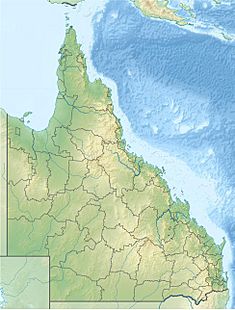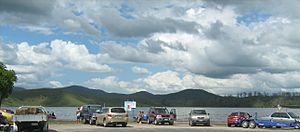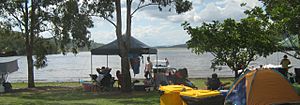Somerset Dam facts for kids
Quick facts for kids Somerset Dam |
|
|---|---|
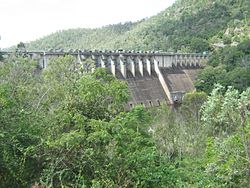
Wall of Somerset Dam
|
|
|
Location of the Somerset Dam in Queensland
|
|
| Country | Australia |
| Location | South East Queensland |
| Coordinates | 27°6′52″S 152°33′25″E / 27.11444°S 152.55694°E |
| Purpose |
|
| Status | Operational |
| Construction began | 1935 |
| Opening date | 1959 |
| Operator(s) | SEQ Water |
| Dam and spillways | |
| Type of dam | Gravity dam |
| Impounds | Stanley River |
| Height | 50 m (160 ft) |
| Length | 305 m (1,001 ft) |
| Width (base) | 41 m (135 ft) |
| Dam volume | 203×103 m3 (7.2×106 cu ft) |
| Spillway type | Gated |
| Spillway capacity | 4,650 m3/s (164,000 cu ft/s) |
| Reservoir | |
| Creates | Lake Somerset |
| Total capacity | 904,000 ML (199×109 imp gal; 239×109 US gal) |
| Active capacity | 380,000 ML (84×109 imp gal; 100×109 US gal) |
| Inactive capacity | 524,000 ML (115×109 imp gal; 138×109 US gal) |
| Catchment area | 1,330 km2 (510 sq mi) |
| Surface area | 4,350 ha (10,700 acres) |
| Maximum length | 52 m (171 ft) |
| Maximum width | 7 m (23 ft) |
| Normal elevation | 108 m (354 ft) AHD |
| Power station | |
| Name | Somerset Dam |
| Commission date | 1959 |
| Installed capacity | 3.2 MW (4,300 hp) |
| Annual generation | 12 GWh (43 TJ) |
The Somerset Dam is a large concrete dam in Queensland, Australia. It was built across the Stanley River. You can find it in the Somerset Region of South East Queensland.
Its main job is to provide clean drinking water for big cities like Brisbane, Gold Coast, and Logan City. It also helps stop floods, offers fun activities, and makes electricity. The big lake behind the dam is called Lake Somerset.
The dam, the lake, and the nearby village are all named after Henry Plantagenet Somerset. He was a local farmer and a member of the Legislative Assembly of Queensland. He represented the area from 1904 to 1920.
Contents
About Somerset Dam: Location and Features
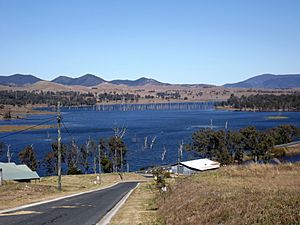
The Somerset Dam is about 115 kilometres (71 mi) northwest of Brisbane. It is also about 80 kilometres (50 mi) north of Ipswich.
The dam's concrete wall is 50 metres (160 ft) high and 305 metres (1,001 ft) long. This huge wall holds back a massive amount of water. When full, the reservoir can hold 904,000 megalitres (31,900×106 cu ft) of water.
Only 380,000 megalitres (13,000×106 cu ft) of this water is used for drinking supply. The rest is kept to help control floods. The dam collects water from a large area of 1,330 square kilometres (510 sq mi). This area includes parts of the D'Aguilar National Park.
Lake Somerset sits 108 metres (354 ft) above sea level. Its surface covers about 4,350 hectares (10,700 acres). The dam has special gates that can release 4,650 cubic metres per second (164,000 cu ft/s) of water.
Since July 2008, SEQ Water has managed the dam. This was part of a plan to make sure South East Queensland has enough water. A small power station next to the dam can make 4 megawatts (5,400 hp) of electricity.
Dam operators try to keep the water level at 90% capacity. This helps reduce how much water evaporates. They release water into the Wivenhoe Dam downstream to maintain this level when new water flows in.
Building the Dam: A Big Project
The idea for a dam here came after a huge flood in Brisbane in 1893. Henry Plantagenet Somerset first suggested this spot. In 1928, experts agreed that Stanley Gorge was a good place for a dam.
However, construction did not start until 1933. The Forgan Smith Labor Government decided to build the dam. It was a major project to create jobs during the Great Depression.
Work began in 1935. Homes and other buildings were needed for the 1,000 construction workers and their families. By 1942, the dam was almost finished. But then, workers had to stop and help with the war effort. Many went to build the Cairncross Dockyard in Brisbane.
Work on the dam started again in 1948. The dam opened in 1953 when the main structure was done. It was officially named after Henry Somerset in 1958. All work, including the hydroelectric power station, was completed in 1959.
Fun at Lake Somerset: Recreation and Fishing
There are two main places for the public to visit at Somerset Dam: Kirkleigh and The Spit. Both spots have concrete boat ramps. They also have facilities for people visiting for the day.
You can go camping and bring caravans at Kirkleigh. There is also camping below the dam wall at Somerset Park. During busy times, these camping areas can get very full. Kirkleigh can hold up to 2,200 campers, and Somerset Park can hold 800. Lake Somerset Holiday Park's Kirkleigh campground also has cabins by the water. You can access the dam directly from a grassy area there. The dam has 30 kilometres (19 mi) of water where boats can travel.
Fishing in Lake Somerset
Lake Somerset is a very popular place for fishing. It is one of the top five fishing spots in Queensland. Many types of fish live in the dam. These include Australian bass, golden perch, silver perch, and Mary River cod. You might also find bony bream, eel-tailed catfish, and Queensland lungfish.
To fish in the dam, you need a special permit called a stocked impoundment permit.
Images for kids
Engineering Heritage Award
The Somerset Dam has been recognized as an Engineering Heritage National Landmark. This award comes from Engineers Australia. It is part of their program to celebrate important engineering achievements.


